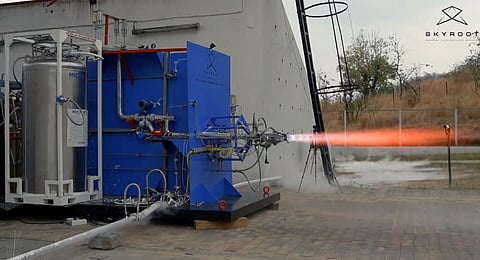

HYDERABAD: Skyroot Aerospace has achieved another milestone by successfully test-firing an advanced 3D-printed cryogenic engine for a duration of 200 seconds, a record for the company. The endurance test of ‘Dhawan-II’ which demonstrated impressive performance results, was carried out at the Solar Industries propulsion test facility in Nagpur, Maharashtra, using Skyroot’s indigenously developed mobile cryogenic engine test pad.
This achievement follows the November 2022 launch of Vikram–S, which made Skyroot the first Indian private company to send a rocket into space and showcased the disruptive potential of India’s emerging private space industry. Pawan Kumar Chandana, Co-founder and CEO of Skyroot Aerospace, stated, “The successful test of Dhawan-II is a landmark achievement for the company and the Indian private space sector. We are proud to be at the forefront of developing cutting-edge cryogenic technologies in the private space sector of India, and pushing the limits with advanced technologies like 3D printing and green propellants.”
The Dhawan-II engine builds upon the foundation laid by Skyroot’s first privately developed fully-cryogenic rocket engine, the 1.0 kN thrust Dhawan – I, which was successfully test-fired in November 2021.The cryogenic engine series is named after Dr Satish Dhawan, an eminent Indian rocket scientist who played a crucial role in the development of the Indian space programme.
Naga Bharath Daka, Co-founder and COO of Skyroot Aerospace, added, “This is a major milestone for our cryogenic propulsion programme, which will enhance the payload capacity of Vikram series of space launch vehicles making them more modular so as to meet wider customer requirements.”
Skyroot’s cryogenic rocket engines utilise two high-performance rocket propellants, Liquid Natural Gas (LNG) and Liquid Oxygen (LoX), which require cryogenic temperatures (below -150° Celsius) for storage and operation.Fully cryogenic engines are ideal for the upper stages of a rocket due to their higher specific impulse, which greatly enhances payload-carrying capabilities.